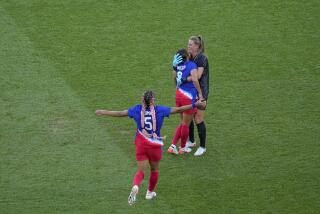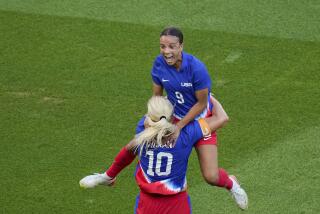Having an Olympic Team Is Their Miracle on Ice
- Share via
LAKE PLACID, N.Y. — Erin Whitten is accustomed to seeing double takes when she tells people her vocation.
“I’m 5-5 and I don’t look like a hockey player, I’m told. I don’t have any stitches and I have all my own teeth,” she said. “For the most part, when people find out, they just say, ‘Oh, we have a national team?’ ”
Not only does the U.S. have a national team, Whitten is its top goaltender. And because of her talent, she might win an Olympic medal next year at Nagano, Japan.
Whitten, the second woman to play in a professional hockey game and the first to win one, will lead the U.S. team in the women’s world hockey championships March 31-April 6 in Kitchener, Canada. The tournament will determine the qualifiers and seedings for the 1998 Olympics, which for the first time will feature women’s hockey as a medal sport.
But it wasn’t the dream of Olympic glory that drew Whitten or her teammates to the sport. Many took their first wobbly steps on the ice when they were 2 or 3, and all have played hockey since childhood, usually as the only girl on a boys’ team.
They play for the love of it. It can’t be for the money, since there isn’t any. Only four schools award women’s hockey scholarships and there are no women’s professional leagues.
But there’s no question, the inclusion of women’s hockey in the Olympics has changed things. The women who play have seen their friends’ priorities change to careers and families, yet they still are practicing wrist shots and three-on-twos. “My life has been majorly postponed,” said Lisa Brown-Miller, who resigned as coach of Princeton’s women’s team to join the national team and is one of the oldest players at 30. “I’m married now and you start to think about kids, but I can’t do that now.
“For me, this is a once-in-a-lifetime chance. Younger players may have the chance to play in one or two Olympics. I don’t. I have one chance. For me, the light is at the end of the tunnel.”
That light also captivates Cammi Granato, 26, a mainstay on the national team since its inception in 1990. “For a year or two, it was really tough to watch my bank account go down,” said Granato, the younger sister of San Jose Shark winger Tony Granato. “I’m still just scraping by. But I feel fortunate that I’m living out a dream. I’ve got to enjoy every moment.”
They will experience their biggest moment in Nagano, where the difficulty of being trailblazers will be balanced by the pride of knowing they have smoothed the path for those who will follow.
“I played on boys’ teams until ninth grade, then I played with girls,” said center Meaghan Sittler, daughter of NHL Hall of Famer Darryl Sittler. Meaghan, 21, a junior at Colby College in Waterville, Maine, didn’t make the team for the world tournament but is a candidate for the 1998 Olympic squad.
“It’s come so far, even since I was 15. To see the number of girls that are playing now is great. There’s so many and there’s a lot of teams in college. Every year the competition gets better,” said Sittler.
Said center A.J. Mleczko, “I go to Harvard, and when I got there people would say, ‘Oh, women play hockey?’ The awareness is growing, but the Olympics will definitely help increase that.”
With the Olympics less than a year away, USA Hockey, the sport’s administrative body, is pouring unprecedented effort and resources into the women’s program.
In response to growth in participation--the number of female players registered in USA Hockey programs rose from 5,573 in 1990-91 to 20,555 in 1995-96, and the number of teams grew from 149 to 710--a national junior team was formed and training camps were organized. Before the world tournament, the team trained here, the scene of the greatest triumph in U.S. hockey history, for three weeks.
“Being here gives me chills,” Mleczko said of the 1980 men’s team’s upset of the Soviets and subsequent gold-medal victory, which occurred when she was 4.
But the most crucial advance for the women’s program occurred last June, when Ben Smith signed a three-year contract to be the national team’s first full-time coach, director of the women’s development program and coach of the Olympic team. Smith coached the men’s team at Northeastern University in Boston, was an assistant with the 1988 men’s Olympic team at Calgary and coached men’s teams at three U.S. Sports Festivals. He was intrigued by the idea of spreading the gospel of women’s hockey to a potentially immense audience.
“This is a real ground-breaking thing, a situation where women’s hockey has been played almost as an underground cult sport mostly in the Northeast,” Smith said. “Its emergence as a medal sport is going to encourage women and girls to begin playing, or, if they’re already playing, show them the opportunities that are available.”
To see how he would fare coaching the women--and how they would respond to him--he took a select team to Finland in 1995.
“I was very impressed with the dedication and focus of the players,” he said. “This is as good a group as I’ve ever coached.”
The feeling is mutual.
“Coach Smith is a good influence on everybody,” said goaltender Whitten. “It’s a combination of having him permanent and his personality that’s given us a good feeling.
Said defenseman Kelly O’Leary, a member of the national team since 1990, “He’s the reason I stuck with it. I was ready to hang ‘em up. He’s been great.”
O’Leary’s hockey background is typical. She grew up in Auburn, Mass., and played because her older brothers did, wearing hand-me-down or altered gear. (Only recently did a manufacturer, Louisville, design equipment tailored to women’s narrower waists and wider hips).
She played at Providence College, one of the few schools that offer women’s hockey scholarships, and went to Switzerland to hone the skills that make her a creative passer and agile skater. She can’t imagine doing anything else--and can’t imagine why anyone can’t comprehend her passion for the game.
“This is what I want to do,” said O’Leary, 29. “I can’t work because of training, but I’m going for a master’s degree and hope to finish that.”
Whitten grew up in Glens Falls, in central New York State. She took up hockey when she was 8 because “everybody in the neighborhood was playing,” and she played on boys’ teams. Because she was a goalie and relied on agility and athleticism rather than size and strength, the gender difference didn’t mean much--at least until she followed Manon Rheaume into the pro ranks and became the first woman to win a game, with Toledo of the East Coast Hockey League in October 1993.
Whitten, 25, also played in the Central and Colonial Leagues, low rungs on hockey’s minor league ladder, and had tryouts with the American and International leagues, the NHL’s top feeder leagues.
“It wasn’t a big deal as far as me being female,” she said. “It was accepted right through high school and college.
But other women faced skepticism from the start. Mleczko’s family was supportive but her neighbors were horrified.
“Other parents were saying to my parents, ‘Why are you letting her play?’ ” she said.
Brown-Miller was 6 when she told her father she wanted to play hockey.
“He thought it would be a passing phase,” she said. “We hit a sporting goods store and bought equipment and I played, but he thought I’d get tired of it. Now he carries my card in his wallet and I know he’s proud of me.”
At 5-feet-1 and 127 pounds, Brown-Miller is the smallest on a team whose players average 5-7 and 146 pounds. But size matters less in women’s hockey than in the men’s game because there’s more emphasis on finesse than strength. There’s no body checking, no drilling anyone through the boards, but that doesn’t mean it’s dainty.
“There’s definitely contact,” Granato said. “It gets pretty intense sometimes, especially when we play Canada. We’ve had players get broken bones. I broke a bone in my leg and had a broken wrist.”
Canada is the U.S. team’s main rival. Canada, the U.S. and Finland have finished 1-2-3 in the three previous World Championships, but the U.S. women say they’re ready to change that.
“Every year we’re closing the gap,” Granato said. “Every year we’re closer.”
More to Read
Go beyond the scoreboard
Get the latest on L.A.'s teams in the daily Sports Report newsletter.
You may occasionally receive promotional content from the Los Angeles Times.







